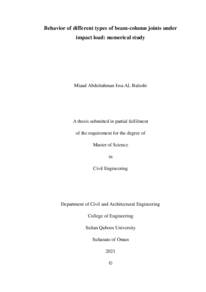Document
Behavior of different types of beam-column joints under impact load : numerical study.
Identifier
AL-Balushiyah, Miaad Abdulrahman Issa (2021). Behavior of different types of beam-column joints under impact load : numerical study (Master thesis, Sultan Qaboos University, Muscat, Oman).
Publisher
Sultan Qaboos University.
Gregorian
2021
Language
English
English abstract
Both accidental and intentional actions may impose an extreme impulsive load on the
beam-column joints of a building. Limited knowledge concerning the behaviour of
joints subjected to such loadings has been developed. This study presents a numerical
study of steel beam-column connections under impact load. The non-linear finite
element software LS-DYNA was employed to develop detailed 3D finite element
models. Most common types of beam-to-column connections, named flush plate
connection (FPC), partially depth end plate connection (PDEPC), and fin plate
connection (FP), are selected to be numerically studied in this thesis. The accuracy of
the finite element models is validated against experimental results. Comparison
between numerical and published experimental results demonstrate that the models are
capable of predicting the dynamic responses of beam-column joints under impact
loading with reasonable accuracy in terms of impact load, vertical displacement, and
connections deformation mode. A series of parametric studies are conducted for the
validated models to extend the study of joints behaviour under impact load. The
parameters include effect of number of bolts, plate thickness, impact velocity, and
impact energy. Based on the parametric study, the displacement showed a proportional
relation with number of bolts and plate thickness, an inverse relation with the impact
velocity. Energy balance model between impact energy and absorbed energy was
developed, a good result was obtained. It is concluded that the FPC showed higher
impact moment resistance than the PDEP and FP. It is found that LS-DYNA is an
effective tool to simulate the behavior of beam-column connections under impact
load.
Member of
Resource URL
Arabic abstract
قد تفرض كل من الإجراءات العرضية والمتعمدة حملا اندفاعيا شديدا على العمود في المبنى. تم تطوير اندفاعيا شديدا على مفاصل المعرفة فيما يتعلق بسلوك المفاصل المعرضة لمثل هذه الإحمال. تقدم هذه الرسالة دراسة عددية لتوصيًلت العمود الفوالذي تحت أحمال التصادم. تم استخدام برنامج DYNA-LS للعناصر المحدودة غير الخطية لتطوير نماذج مفصلة ثًلثية الإبعاد للعناصر المحدودة. تم اختيار معظم أنواع التوصيلات من الحزمة إلى العمود ، مثل توصيل لوحة التدفق المسماة )FPC ، )ووصلة لوحة النهاية الجزئية )PDEPC ، )ووصلة لوحة الزعانف )FP ) ، ليتم دراستها عددياا في هذه الإطروحة. يتم التحقق من دقة نماذج العناصر المحدودة مقابل النتائج التجريبية. توضح المقارنات بين النتائج التجريبية العددية والمنشورة أن النموذج قادر على التنبؤ بالإستجابات الديناميكية لمفاصل عمود الحزمة تحت تحميل الصدمات بدقة معقولة من حيث حمل التأثير والإزاحة الرأسية ووضع تشوه التوصيلات. يتم إجراء سلسلة من الدراسات للنماذج التي تم التحقق من صحتها لتوسيع دراسة سلوك المفاصل تحت تأثير الحمل. تتضمن المعلمات تأثير عدد المسامير اللولبية وسمك اللوحة وسرعة التأثير وطاقة الصدم. بنا اء على الدراسات ، أظهرت الإزاحة عًلقة تناسبية مع عدد البراغي وسمك اللوحة ، وعًلقة عكسية مع سرعة التأثير. تم عمل نموذج توازن الطاقة بين طاقة الصدم والطاقة الممتصة وتم الحصول على نتيجة جيدة. وخلص إلى أن FPC أظهرت مقاومة لحظية ذات تأثير أعلى من PDEP و FP .لقد وجد أن DYNA-LS هي أداة فعالة لمحاكاة سلوك توصيًلت عمود الحزمة تحت حمل التأثير.
Category
Theses and Dissertations

